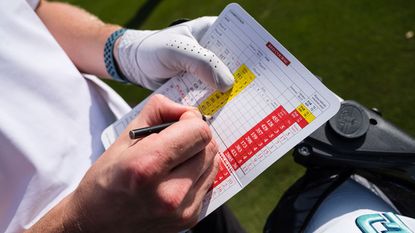5 Golf Rules You NEED To Know
Jeremy Ellwood explains the five Rules of Golf you need to know


Jeremy Ellwood explains five Rules of Golf you need to know, including those around provisional balls, unplayable lies and what you can and can't do in bunkers
5 Golf Rules You NEED To Know
Jeremy Ellwood explains the 5 Rules of Golf you need to know, including those around provisional balls, unplayable lies and what you can and can't do in bunkers.
Related: New golf rules - all you need to know
Here are the 5 golf rules you NEED to know...
1. The Scorecard
A few things on the scorecard - firstly, you don't record your own score. Your marker records your score and, at the end, if the marker had made a mistake and you don't spot it before you sign, then that is down to you as the player.
Get the Golf Monthly Newsletter
Subscribe to the Golf Monthly newsletter to stay up to date with all the latest tour news, equipment news, reviews, head-to-heads and buyer’s guides from our team of experienced experts.
If you sign for a gross score higher than what you took on a hole, that score will stand. However, if you sign for a gross score lower than what you took, you will unfortunately be disqualified.
All you have to do on a scorecard is write the gross score on each hole. You don't have to add up your Stableford points or anything like that. ALL you have to do is record and sign for the correct gross scores for each hole.
You must get your scorecard posted in good time after the round too, and that doesn't mean after a few beers in the clubhouse!
Related: Why you SHOULD mark your golf ball
2. Unplayable ball
You, as the player, are the sole judge as to whether your ball is unplayable. You could, if you wanted, declare your ball unplayable from the middle of the fairway, but obviously you would rarely, if ever, want to do that.
If you declare your ball unplayable, you then have three options. First, you can go back to where you last played from under penalty of stroke and distance.
The second option is to drop within two club lengths of where your ball is lying but no nearer the hole, again under penalty of one stroke.
Your third option is to drop back as far as you like on a line keeping the point where your ball is currently lying between you and the flagstick, again under penalty of one stroke.
3. Provisional ball
The idea of the provisional balls is that if you hit your ball somewhere you may not find it, as long as it's not in a penalty area, you can then hit a provisional to potentially save you a long walk back.
You HAVE to make it clear that you are playing a provisional ball before you hit - you can say, "I'm going to hit another just in case," but our advice would be that it's probably best to use the words 'provisional ball' to avoid the potential for confusion.
If you find your original ball, your provisional ball is then immediately out of play. You cannot play your provisional ball, even if you find your original ball in an undesirable spot.
The point of the provisional ball is to save time. If you're in any doubt as to whether or not you'll find your original ball, hit a provisional and remember to declare it first.
Related: Golf Rules Explained - Provisional Ball
4. Definitions - Nearest point of complete relief
The nearest point of complete relief doesn't mean 'nicest' point of relief. Sometimes the nearest point of relief may be in a bush so it could sometimes be better to play from where it is lying, even if it's on a cart path.
If you are taking a drop away from an immovable obstruction or abnormal course condition, you must take complete relief. This means you cannot drop the ball in a position where you would still be standing on the condition or obstruction from which you are taking relief.

5. Various bunker rules
Some key things you can and can't do in bunkers:
You are not allowed to ground your club in the sand or take practice swings striking the sand - the only time you can hit the sand is at impact. If you do ground your club, then you will be penalised.
You may now remove loose impediments from a bunker as elsewhere on the course, taking care not to move your ball in the process.
If you wish to declare your ball unplayable in a bunker, you have a few relief options.
Three of them are as per the normal options for an unplayable ball under penalty of one stroke. If you opt to drop within two club-lengths or back on line, it must be in the same bunker.
There is now one further option for an additional penalty stroke. This extra penalty stroke then allows you to drop back on line outside the bunker.
Here is everything you need when you decide to declare your ball unplayable in a bunker.
The Rules of Golf can, at times, seem complicated and intimidating. Hopefully, this article will help you know what to do in a number of very common scenarios.
For more rules content check out the Golf Monthly website.

Elliott Heath is our News Editor and has been with Golf Monthly since early 2016 after graduating with a degree in Sports Journalism. He manages the Golf Monthly news team as well as our large Facebook, Twitter and Instagram pages. He covered the 2022 Masters from Augusta National as well as five Open Championships on-site including the 150th at St Andrews. His first Open was in 2017 at Royal Birkdale, when he walked inside the ropes with Jordan Spieth during the Texan's memorable Claret Jug triumph. He has played 35 of our Top 100 golf courses, with his favourites being both Sunningdales, Woodhall Spa, Western Gailes, Old Head and Turnberry. He has been obsessed with the sport since the age of 8 and currently plays off of a six handicap. His golfing highlights are making albatross on the 9th hole on the Hotchkin Course at Woodhall Spa, shooting an under-par round, playing in the Aramco Team Series on the Ladies European Tour and making his one and only hole-in-one at the age of 15 - a long time ago now!
Elliott is currently playing:
Driver: Titleist TSR4
3 wood: Titleist TSi2
Hybrids: Titleist 816 H1
Irons: Mizuno MP5 5-PW
Wedges: Cleveland RTX ZipCore 50, 54, 58
Putter: Odyssey White Hot OG #5
Ball: Srixon Z Star XV
-
 New Balance 997 SL Golf Shoe Review
New Balance 997 SL Golf Shoe ReviewNew Balance produce some extremely stylish footwear and, in this review, Matt Cradock takes their spikeless 997 SL onto the course
By Matt Cradock Published
-
 I’ve Been A Single-Figure Golfer For 30 Years. These Are The Seven Keys To Getting (And Keeping) A Low Handicap
I’ve Been A Single-Figure Golfer For 30 Years. These Are The Seven Keys To Getting (And Keeping) A Low HandicapIt takes time and it takes a bit of work, but there are key techniques and strategies you can employ to reach your golfing goals
By Fergus Bisset Published